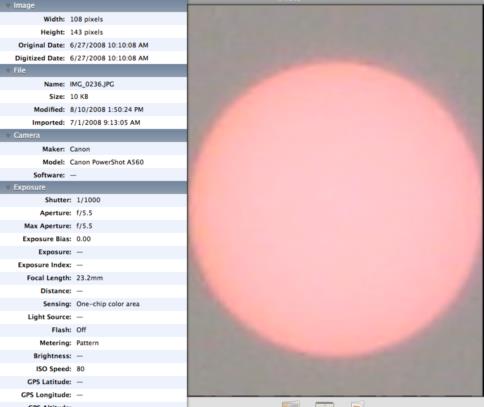
NavList:
A Community Devoted to the Preservation and Practice of Celestial Navigation and Other Methods of Traditional Wayfinding
Fw: Digital Solar Image
From: George Huxtable
Date: 2008 Aug 11, 16:28 +0100
From: George Huxtable
Date: 2008 Aug 11, 16:28 +0100
Greg Rudzinski kindly sent me two images off-list, with this note- | Image IMG 0236.JPG is an original. | | Picture 25 is a cropped and zoomed version of IMG 0236.JPG | | The original image that you requested (Picture 11.PNG) has unfortunately been deleted from my photo files. The attached photo is a similar photo taken through 1/8" white plex. Let me know exwactly what you need and I will gladly take additional photos and forward them to you. ========= IMG 0236.JPG was about 1 Megabyte, mostly of empty space surrounding a Sun, which occupied just over 100 x 100 bytes, or so. So I have removed that picture, and replaced it by IMG_0266-2.JPG, a cropped-down version of the same thing, which shows only the Sun, with a bit of border, at 150x 147 pixels. I hope Greg doesn't mind me taking such liberties with his pics. Those should keep even Bill happy, in terms of download size. So those two pictures are essentially from the same Sun image, cropped down, but picture 25 has then been zoomed-up before transmission, the other one remains as is. Unexpanded, in the 150 x 147 image it is of course impossible to see the details, and some software, if you try to zoom in, seems to want to smooth over the jags as it expands, creating those very effects at the Sun boundary that I have found so puzzling. However, I've found that if I first save it, then open it with Adobe Photoshop LE (a crippled version of the real thing), then I can use the gain slider on its navigator panel to expand it up, and the picture of the Sun remains just as "blocky" as was the original image, allowing us to investigae the real picture of the Sun as it left the camera. The blockiness of this picture is just as we would expect, and the curious flame-like edges that the zoomed-and-smoothed images showed, are happily absent. They must have been caused by a smoothing algorithm trying to work its magic on an image for which it was completely unsuited. Now we can move the mouse ponter over that 150 x 147 Sun image, and the info window gives the coordinates of each pixel, as we point to it, together with RGB (red-green-blue) values for that pixel, and also the same thing expressed in different terms,.as hue, saturation, and brightness. It seems to me that it's only the brightness that's of real interest here, and I can give the results of a pixel-by-pixel horizontal pass, across the Sun's (guessed) midline, at y = 77. The results may be rather surprising. Brightness is given as a percentage, with 100% as the possible maximum (of course). I will omit the "%" sign, and just give a string of percentage brightnesses at increasin x-values, from left to right across the face of the Sun. The background sky, anywhere near the Sun appears to be quite brightly lit at this exposure, and from the left edge of the cropped frame, at pixel x =1, the brightness is 67%, for all cells up to and including x=15. Then counting from x=16, the brightness percentages go, in order,- 70, 69,69,69,71,73,77,78,88,89,95,96,100,100,100 by which time, if I've been counting correctly, we have got to the cell for which x=30. Then subsequent cells, right across the face of the Sun, are all uniformly 100% brightness, showing that the camera sensor is completely saturated and overexposed. That's true right across to the right hand limb, which we are approaching when x=120, starting at which we get the following brightness values- 100,99,99,99,98,98,98,98,97,95,88,85,78,76,71,71,69,68,and 68 at x=138. Then 68%, or sometimes 67%, to the right-hand edge of the frame, at x=149. So those brightness values don't look much like our familiar picture of a sharp-edged Sun disc, do they? What brightness level should we take to be the contour that represents the limb of the Sun, to determine its exact diameter? I wouldn't like to guess. Things may be a bit better than they seem, just from that one-pixel -wide scan, in that other pixel rows, just above and just below, can be called in aid to assist the assessment. But none of those other rows is any more sharp-edged than that one was. A vertical scan would look very similar, and the mid-point of that scan would be needed to assess the Sun altitude. That could be done rather well, just from symmetry, in spite of the unsharp edges. George. contact George Huxtable at george@huxtable.u-net.com or at +44 1865 820222 (from UK, 01865 820222) or at 1 Sandy Lane, Southmoor, Abingdon, Oxon OX13 5HX, UK. --~--~---------~--~----~------------~-------~--~----~ Navigation List archive: www.fer3.com/arc To post, email NavList@fer3.com To , email NavList-@fer3.com -~----------~----~----~----~------~----~------~--~---








